
The Head
From an aesthetic point of view, the head is the most distinguishable part of any breed. To demonstrate how important head shape is to any breed, I have placed two photos of females below and blocked out their heads. Now look at the photo’s and try to distinguish what breed of dog they are?


Now, turn the page and look at the photos. Did you guess right? Both bodies looked similar, but when the head is shown, it is immediately clear that they are different breeds. I hope this has demonstrated how important the shape of the head is to any breed.
The head of the Boerboel is no different in significance. It may even be more important in distinguishing the breed, because there are many breeds with a comparable body size, shape and colour with the Mastiff-type of head. Also, when people take away focus from breeding the correct shaped head, you can quickly see other breeds taking over the shape of the head. If the dog has too much stop, it begins to look like a Bullmastiff, if the muzzle is wedge shaped, and too long, it looks more like a Hound or Labrador. A correct Boerboel head is a distinct feature of the breed and unlike that of any other breed of dog.
Before I go any further, it needs to be clear that the Boerboel is not a “head breed” (having a breed standard, or a judging bias, which disregards other faults, just to get the “correct” head). Nor do I want these words to turn the Boerboel into a head breed, but I am trying to describe the perfect Boerboel. However, at this point in time, the Boerboel head needs to be addressed immediately. For too long, appraisers and breeders have been focusing their attention on the hindquarters of the breed and forgotten about everything else; most notably, heads and temperaments.
The idea of the Boerboel head is that it should be blocky. The best way to describe this “blockiness,” is if you start with a solid concrete or stone building block, and you begin to chisel away at it. You will need to chisel away a minimal amount before you have a Boerboel head. If you start with a round stone, similar in shape to a rugby football, you could chisel out a Bullmastiffs head without removing much stone. If you were to try and chisel out a Boerboel head, from that same round stone, you would realise that there is already too much of the stone missing for it to be practical to do so.
If you can understand this “stone-block” analogy of the head, you will realise that most points in the breed standard, regarding the head, go towards creating this “blocky shape”.
If you can understand the entire concept of the correct Boerboel head, you will also realise that…
A PROPER Boerboel head is like that of NO OTHER BREED!

Schematic front, top and side view drawing of the correct Boerboel head.
The head is impressive and a distinctive feature of the Boerboel.
It is blocky, broad, deep, fairly short and in proportion to the body.
The term “blocky” is probably the most important term. It gives the Boerboel his distinctive look. When a head is round from the front, it is more like a Bullmastiff head, and if it is more wedge shaped than blocky, when viewed from the top or the side, it will look more like a Staffordshire Bullterrier, or Labrador head. Regarding proportion to the body, I don’t want to give exact measurements of head circumference relative to height, but as a very rough guide: A male Boerboel, with a well proportioned head, will have a similar circumference, at the largest point on the head, to the dog’s height at the withers. Also, regarding proportion of the head to the body, it is important to note that the female’s head is smaller than the male’s head, relative to their body size. So, if you were to have a small male who is the same height as a larger female, his head should be noticeably bigger than hers.
It is muscular with well-filled cheeks.
The cheeks are not prominent like a Staffordshire Bullterrier, but they are well-filled. The Boerboel head is muscular, but not overly muscled like some other breeds.
The roof of the cranium (skull) is square, flat and muscular.
Here we are describing the area of the head between the ears and down to the eyes. It needs to be flat, to give the blocky profile we are after. If the top of the head is round, it looks more like a Bullmastiff head. If it is overly muscled, it begins to look more like a Staffordshire Bullterrier head.
The zygomatic arch (cheekbone) is well muscled, but not too prominent.
This “cheekbone” is where the muscles for the jaw are threaded through and are attached to the top side of the skull. The important point to make here is that it should not be prominent. The more rounded or prominent the zygomatic arch is, the more muscle is passing through it and attaching both on top of the head and on the jaw. This is why the Staffordshire Bullterrier and the Bullmastiff have large cheeks, and the tops of their heads are rounded due to the large amounts of muscle attachments. The Boerboel has a zygomatic arch that is more flat than rounded, which doesn’t allow for a great deal of muscle. This, in turn, creates a skull that is flat on the top and relatively flat on the sides.
The stop is definite, but not prominent, gradually sloping and well filled between the eyes.
The stop is the transition point where the forehead changes into the nose/muzzle of the dogs head. The English Bullterrier has no stop, where as the Dogue de Bordeaux has a very prominent stop. The Boerboel does have a stop, but it is smooth flowing. When viewed from the side, it starts from the plane of the top of the head, gradually joining the plane of the top of the muzzle, which is at a lower level, relative to the top of the head.
The point about being well-filled between the eyes is one of those defining points that give the Boerboel his distinctive look. Having the eyes widely spaced and in-between the eyes “well filled,” is the difference between a dog looking like a Boerboel or not. If you have the eyes spaced wide apart, and have an indent between the eyes, the indent will give the head a Bullmastiff look. The indent will also almost always continue all the way up the forehead, creating a split between the halves of the head. Once again, this is a Bullmastiff trait. If the eyes are too close together, relative to the back of the head, it creates the wedge shaped head of either a Staffordshire Bullterrier, or sometimes, if there is not a lot of muscle and the head still looks square from the front, a Labrador-looking head.
It should not be steep, or an almost straight line between the nose and the occiput.
This point is describing the difference in height between the top line of the skull and top line of the muzzle. The occiput is the back of the head. If it were a straight line between the nose and the occiput, the head would look more like a lion head than a dog head. If the stop is too steep, it is more like an English Bulldog head. If the gap between the top line of the head and the top line of the muzzle is too big, it will take away from the depth of the muzzle. So, the correct head has a slight gap between the two planes, which is noticeable, but not prominent.
The muzzle is broad, deep, well attached, filled below the eyes and narrows slightly towards the nose. The top line is straight and almost on a parallel plane with the cranial roof.
This is a feature of the breed that very few people understand, but which is extremely important when trying to create a dog with the correct head shape. I will begin by describing the muzzle and head from side view first, because it is a much easier concept to understand.
When looking at the head from the side, the muzzle should be longer than one third the length of the entire head, and shorter than half the length of the head. The top line of the muzzle should be almost parallel to the top line of the top of the cranium. This is where the stop comes in. If the stop (the distance separating the top line of the muzzle and the top line of the cranium) is too large, the muzzle will always appear shallow.
The muzzle needs to be “deep” when viewed from the side. This depth is obtained by having only a slight stop. However, the stop is only one factor in having a deep muzzle. The next is correct dentition and the bottom jaw sitting in the right place. If the bottom jaw is sitting too far inside the top jaw, it will create a wedge shaped head when looking from the side. If the bottom jaw is undershot, it will protrude and create a round look to the bottom of the jaw.
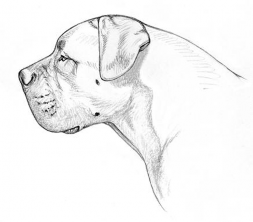
This schematic drawing of the correct head. By having only a slight stop, the Boerboel head allows for a deep muzzle. Even if you were to take away 10% of this dog’s depth of head, his muzzle would still look relatively deep. This head and muzzle are deep and “blocky,” which is what the breed standard asks for.
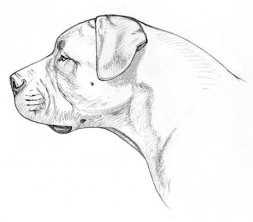
This schematic drawing is of a dog with incorrect dentition. The bottom jaw sits inside the top jaw and creates a “wedge” shaped head when looking from the side. Although the top line of the head and muzzle are correct, the bottom jaw line isn’t deep enough, and gives an overall “shallow” look to the head. This is called “lacking underjaw.”
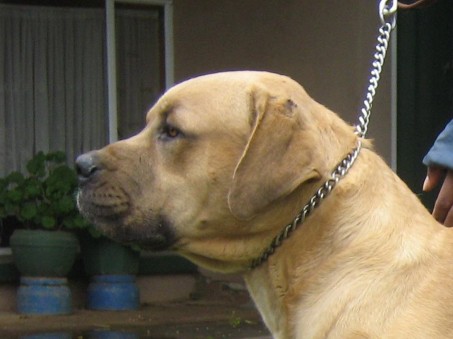
This head is more like a Labrador head than a Boerboel head. It is more wedge shaped than blocky. The front of the muzzle is too shallow, which means the dog’s bottom jaw is not developed enough; this is the cause of the wedge effect.
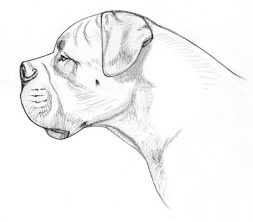
This schematic drawing shows a dog with unparallel planes of the head and muzzle. This creates too much angle between the stop and the muzzle. Whenever there is too much stop, the muzzle does not look as deep when relating back to the depth of skull. It also has incorrect dentition. This dog is undershot, and therefore his lips protrude out beyond its nose. This creates a rounded look to the bottom of the muzzle.
These traits are all typical of the Bullmastiff type of head. The muzzle of this dog is as if it has been turned up from the parallel position it should be in. The length of the muzzle is shorter than the desire 1/3rd of the head length.
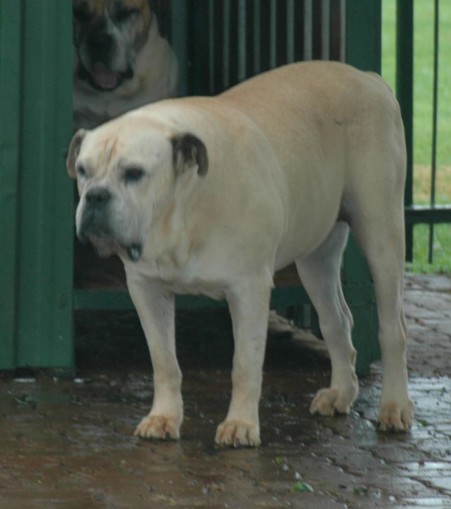
This female has a bulldog type head. Her head is turned up and it is clear that she is also undershot. Other bulldog type traits are her wide chest, round body and her straight rear. This bitch is also very confident, if I had to bet, I would say she probably would show some heart if she was asked to.
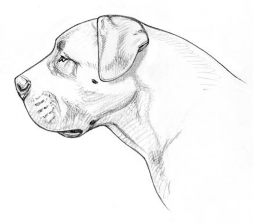
This head is the opposite of the Bullmastiff type. The muzzle turns down, creating an almost Bullterrier-type head. When the muzzle turns down like this, it is often accompanied by a longer muzzle, which gives the head a more hound- like appearance. It is also
harder to get a dog with a wide muzzle, if the muzzle is too long.
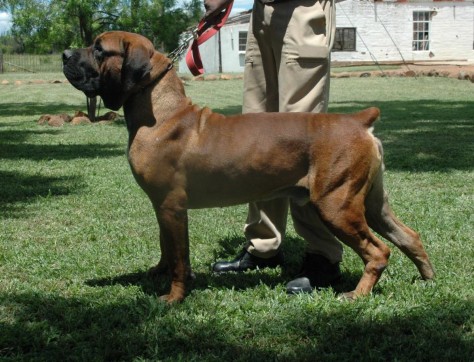
Although this dog has a perfectly straight topline, with good front and rear angulation, his head is more hound like with a longish wedged muzzle and long ears. His head has created an overall look which is more towards a Fila Brasileiro than a Boerboel.
Now that we have the side view explained, let’s start on the trickier front and top view of the correct Boerboel muzzle. The standard first says the muzzle is “broad.” I like to call a good muzzle “THICK.” A muzzle cannot have this desired “thickness” if the eyes of the dog are not spaced wide apart. When the eyes do have the correct spacing, the next thing to look for is where does the muzzle attach to the skull? The muzzle should be so wide, that it reaches out under the dogs eyes (which is where the point of “filled below the eyes” comes in to the breed standard). Also, being so wide on the top of the muzzle, where it attaches to the “well filled between the eyes” stop, it has a fair amount of area that is almost flat, but still has a slight curve to it. This flatness helps produce the blocky appearance.
The next point of the breed standard is very important to interpret correctly. Keep in mind; we are looking to create an overall “blocky” look to the head. The breed standard point of, “and narrows slightly towards the nose,” could have been written as, “narrows ever so slightly towards the nose”. This slight narrowing is hard to see on a live dog, but it is best looked at from above the head standing over the dog. When looking over the muzzle area, you want to look at the outer sides of the muzzle and see that they are almost parallel. Too much tapering in towards the tip of the nose gives a wedge shaped muzzle and head, not a blocky muzzle and head. So, basically, the muzzle should start thick where its width protrudes under the dog’s eyes, and continue this thickness for most of the way, until it gets to the nose, where it has to come in and join the nose. Another point which also gives the muzzle its thickness is the amount of padding the dog has on the muzzle. A dog that has a “well padded,” fleshy lip which extends and covers over the entire muzzle, will have a thicker appearance to the muzzle, which is the desired effect. Dogs with both a wide bone structure and good, thick- padded skin on the muzzle will have the thickest looking muzzles, the most impressive and most correct Boerboel muzzle.
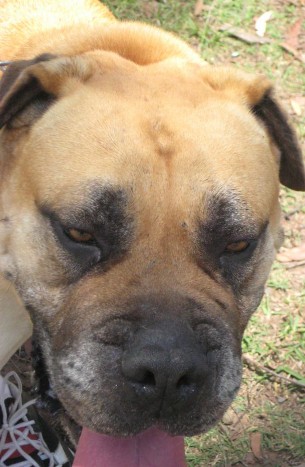
This is Ataraxia Sergeant. Although he is panting, you can still see his thick muzzle. His eyes are wide apart and the sides of his muzzle still extend out to well beneath his eyes. His muzzle is also very well padded, giving it even more volume. When a dog pants, it usually changes the head shape dramatically making the muzzle look thinner. In this case, this dog’s head just looks a bit rounded off on the edges, compared to when he is not panting. Sergeant has one of the best muzzles of any Boerboel I have ever seen.
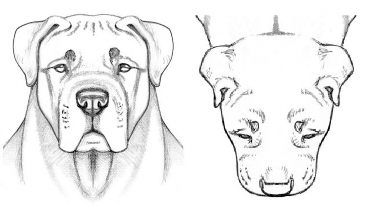
I have recreated the front and top view drawings here so I can talk about the muzzle. When looking at the top view, you can see that the outer lips are almost parallel, and the front of the muzzle is quite square. This is the “blockiness” I am always trying to convey. When looking at the top view, you can also see what I meant when I was using my “stone-block” analogy. When looking at the top view, it is easy to see that if you had a stone block, with similar proportions to the head, that you would not need to chisel away much stone before you got the correct shape of the Boerboel head.
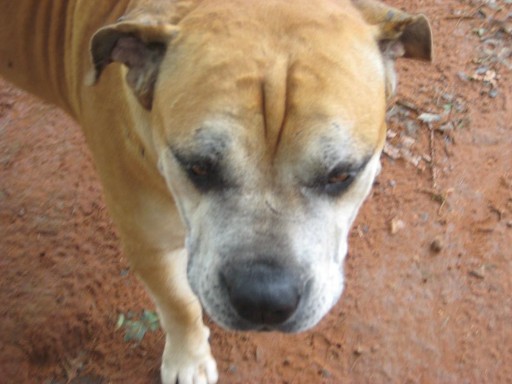
This female Boerboels head has many good points like, wide and full between the eyes. A broad, correct shape and length to her muzzle that has almost parallel sides all the way to the tip. She also has only two wrinkle lines on her forehead which gave her an intelligent look. She has the less desired Ysterberg or Rose ears which take away from her head giving a less blocky shape than if she had the correct triangle shaped ears. All in all a very nice female Boerboel head.
When looking at the Boerboel head from the front, you can see that the muzzle width extends out to be well under the eyes. This is a very important point for two reasons. One; because without extending out to well under the eyes, the muzzle cannot be wide! Two; this is a very unusual trait in any breed and should be conserved in the Boerboel. If the muzzle stays thick all the way to the nose, before it comes in to meet the nose, it will look blocky and powerful when viewed from the front.
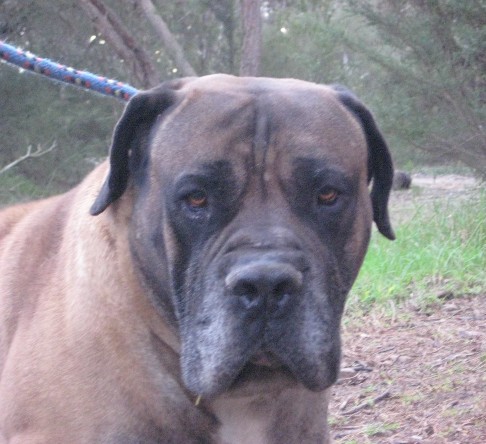
This head is blocky and has most of the desired “Boerboel” traits. It is wide between the eyes and the muzzle width extends out beneath the eyes. The muzzle is thick, all the way to the end. When it gets to the end, it is also blocky. All in all, a very Boerboel-like head.
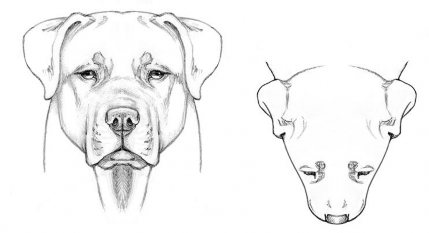
Here is the top and front view of a dog with a “snipey” or “wedge shaped” muzzle. If you look at the top view, it is clear that this dog’s eyes are too close together to be a correct Boerboel head. Once the eyes are too close together, it is virtually impossible for a dog to have a proper “thick” muzzle. This muzzle starts off too thin and tapers in towards the nose, creating a wedge shaped head.
When looking from the front, this dog’s muzzle looks small and weak. It lacks depth and width, especially at the tip near the nose. Once again, there is a definite wedge shape, not the desired blocky shape we are looking for in the Boerboel.
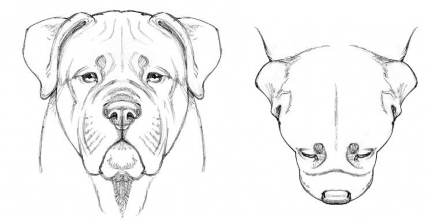
When looking from the front, this Bullmastiff-type head is rounded. Even though the muzzle can be wide with this type of head, the muzzle will usually lack depth; in addition, this head is not of the desired, blocky shape.
When looking from the top, the Bullmastiff-type head usually has a muzzle which is too short, and the roundness of the zygomatic arch creates an effect which makes it seem as though the muzzle is separate from the skull. With a correct Boerboel head, the attachments of the muzzle should flow smoothly to the skull no matter what side you are looking from.
The muzzle measures slightly more than a third of the total length of the head (approx. 10cm for the male and 8cm for the female of ideal height).
Muzzle length is important because if the muzzle is too short, the head will look more like a Bullmastiff. If it is too long, it will begin to look like a hound-type head. The difference in lengths of the male and female muzzles is due to the desired sexual dimorphism. If we go back, the perfect heights of the male being 68cm, and the female being 61cm, the difference in height as a percentage is approximately 10%, but the difference in the length of the muzzles is 20%. If her head were the same size, relative to her body, her muzzle length would be 9cm not 8cm.
This extra 10% decrease in size tells you that the female should have approximately a 10% smaller head than the male, relative to her body size.
The nostrils are large and widely spaced, with the septum (vertical line) of the nose perpendicular to the lower jaw. Once again, the points that are desired go back to having a broad, blocky muzzle. Large and widely spaced nostrils will not be able to fit on a snipey muzzle. Large nostrils are very beneficial to a dog’s breathing and cardiovascular performance; they allow the dog to suck in great amounts of air while having their mouth closed. (while holding an attacker, be it human or animal.)
For the septum to be perpendicular to the lower jaw, we need to go back and look at the side view of the correct head. If the lower jaw fits correctly with the upper jaw, then this perpendicular outline can be achieved. This perpendicular line generates the blocky shape to the front of the muzzle. When the dog is undershot or overshot in the bite, it changes the positioning of this line, taking away from the desired blocky shape.
When looking from the front, the septum also needs to be perpendicular to the lower jaw. Dogs with cleft lips and rei jaws should not be considered for breeding, because of this serious disqualification.
The jaws are strong, deep and wide, and taper slightly to the front.
Here we are talking about the lower jaw and the upper jaw. If you took away all the skin and flesh you have the jaw parts left that we are talking about. Because the muzzle needs to be so thick, and wide, and deep, it only follows that the jaw structure is the same. If the bottom jaw is not thick and strong enough, the dogs head cannot be deep. You can check the jaw structure properly by opening up your dog’s mouth and looking inside it. It should look wide, with only a slight taper towards the front. If it looks too much like a wedge, it is not correct.
The teeth are white, strong, correctly spaced with complete dentition and a scissors bite (limited undershot discriminated against; overshot unacceptable).
The obvious reason here for having correct dentition and a scissor bite is simply for the dogs own health. Also dogs with bad jaws cannot grip and hold their quarry. Consider that when breeding animals, faults in teeth alignment are extremely genetic. It has been proven that the top and bottom jaw grow independently of each other and are controlled by the dog’s genes.
The aesthetic reasoning behind a scissor and slight undershot bite being allowed is due to these factors affecting the head shape, as has been already explained in this chapter.
A quick tip for any dog owner: to keep your dog’s teeth white and strong, there is no better tooth cleaner than fresh meaty bones. There has been a lot of propaganda spread by processed dog food companies, over many years, about feeding a dog bones. But when you sit down and think about what wild dogs eat, then you realise there is no better teeth cleaner or food for your dog.
The upper lip is loose and fleshy. It just covers the lower lip and teeth in the front but should not hide the underline of the lower jaw on the sides.
Having a fleshy upper lip helps with the volume and width of the muzzle. When the upper lip hangs down too far past the jaw, it begins to get too loose and flops around. It also affects the lower lip and jowls. If the upper lip hangs down too far, the dog can begin to look a lot like the other mastiff breeds, such as the Neapolitan Mastiff, and the Dogue de Bordeaux. From the side, the lips should add to the blocky shape of the head.
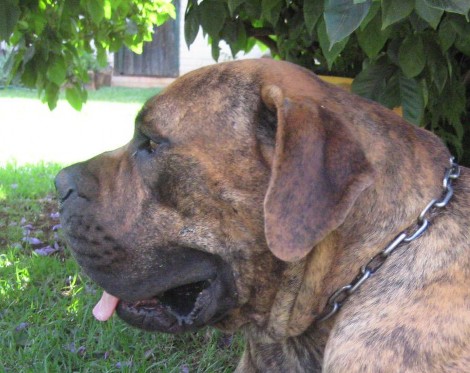
This dog has a nicely shaped upper lip. The front of the lip is perpendicular to the top of the muzzle, and the bottom of the lip is parallel to the top of the muzzle. It is loose and fleshy and when his mouth is closed, it just covers the lower lip. The lower lip is tight up until the jowl area. If the lower lip was loose, this dog would be drooling. This head has good depth in the cranium area and also in the area of the muzzle. The combination of parallel planes of the cranium, the muzzle, and the correct lip shape, give this dog a very blocky shaped head when viewed from the side.
The lower lip is moderately tight without excessive jowls.
The lower lip shape decides whether the dog drools, or the saliva runs back into the dog’s throat as nature intended. The Boerboel should have a moderately tight lower lip, which allows most of the saliva that is created in their mouth to flow back into the dog’s throat and keep the dog hydrated. The looser the bottom lip is, the more a dog will drool.
Drool is undesirable for two reasons. The obvious, it’s messy. The less obvious reason is that the drool or saliva, which is coming out of the dog’s mouth, is fluid which is meant to keep the dog cool and also meant to keep the dog hydrated. All good Dogs that work out in the elements for long periods of time do not drool. They can’t afford to lose that vital fluid and become dehydrated.
The eyes are medium sized, round, forward facing and widely spaced, with an intelligent expression.
I have already talked about the importance of the correct spacing of the eyes. The size and shape are also very important. If the eyes are too big, the dog will look more like an antelope. If they are too small and almond shaped, he will look like a Bullterrier cross. The Boerboel needs to have an intelligent expression. The intelligent expression is a combination of traits which flows from the eyes and is accompanied by having the ears up, attentive, and with a few wrinkles on the forehead.
As explained before, the Boerboels eyes need to be widely spaced apart to have the correct shaped head. Although the average of all Boerboels at this point in time don’t have enough width between the eyes, there is a danger that the eyes are too far apart. If the eyes are too wide, they will be on the side of the dog’s head and will not be forward facing. Also, dogs with their eyes too far apart cannot look intelligent. So, the limit to the width between the eyes will be the point where they are no longer forward facing and/ or the dog does not have an intelligent look on his face, due to the eyes being too far apart.
It is well protected against the environment by firm and black-pigmented eyelids, showing no structural weaknesses.
This is common sense here. The black pigmentation on the eyelids is needed to stop skin cancers. Many white English Bullterriers die before their time, because of skin cancers on their eyelids and even on their nose, where the white/pink skin is exposed due to the short, sparse hair. Structural weaknesses are not named in the standard, but they are entropion (lower eyelid rolling in, toward the eye. This can cause abrasions on the eye) and ectropion (lower eyelid rolling out, away from the eye. This can leave the eye prone to damage and infection from foreign bodies like dust and grass seeds). Both of these problems with the eyes can sometimes be related to the desired “well padded” looking skin.
The colour of the eye is preferably dark brown but all shades of brown (preferably darker than the pelt) are acceptable.
This part is just an aesthetic thing. Often different coloured eyes are related to multi coloured coats like merle.
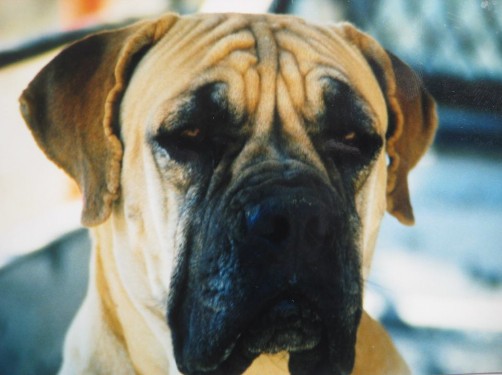
This dog has way too much wrinkle and loose skin around his head (what I call too wet). This loose skin has overflowed into his eyes causing entropion.
The ears are set wide and high and are carried close to the head.
If anything could be changed in the breed standard, for the benefit of the Boerboel, it’s the ears. Ears that sit too closely to the head are unhealthy because they do not let enough air inside the ear cavity, which in turn causes ear infections due to dampness. In nature, there is not a single species that has down ears. Even the elephant, who has ears the size of a table, can move them and flap them, to air out the insides of their ears.
Dogs with correct ears will have a small gap between the part of the ear that is hanging down, and the side of the head. Correct ears will also have enough cartilage and manoeuvrability in the ear to keep air flowing inside the ear.
Rose ears or “Ysterberg ears,” as they are known in the Boerboel fraternity, do not create a square or blocky look to the head like the down, “V-shaped” ears, but they do let in a lot of air to the ear cavity, and do not have even a small percentage of the problems that the standard ears have. The ears need to be set high and wide to complete the flat top line of the skull when the dog is attentive.
They are V-shaped with a broad base tapering to a rounded point that reaches almost down to a line extending from the mouth.
When the Boerboel is attentive, his head looks very angular. This is due to the contribution of the “V-shaped” ears, attached high but wide, on the blocky skull. If a Boerboel is looking straight at you and he is attentive with his ears up, the outer line of the ears and the outer line of the bottom jaw will almost form a straight line. This straight line gives an angular effect to both sides of the head. This is only achieved when the ears are the correct length. The inside part of the ears will appear to come down in a vertical line, close to the side of the head, touching in some parts, giving the skull that desired “blocky” appearance.
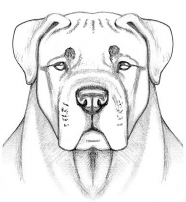
This schematic drawing shows all the desired traits relating to the ears. If you look at the outer edge of both the ears and the jaw lines, you can draw an imaginary straight line that touches the outer edge of the ear, then goes down, and extends and touches the outer edge of the jaw line on each side of the dogs head. You can also draw an imaginary line across the top of the dogs head and ears. The inside edge of the ears touch the skull and are vertical giving that desired blocky look. Almost everything about the Boerboel head is blocky and angular.
When the dog is attentive, the top of the ears and the skull, in between, should form a straight line.
I have already talked about this. The top of the ears is the top of the “V”. The back of the head is flat, and when the ears are held in the correct position, it forms a straight line. This straight line across the top of the head completes the “blocky look that we are after for the Boerboel.
The facial expression should be intelligent, attentive and confident (not evasive, shy or threatening).
The facial expression is very important because it can give an insight into dogs with extremes of temperament who are outside the desired temperament standard for the Boerboel breed.
I think a good time to judge the facial expression is at the appraisal, when there are many different things going on around the dog. The appraiser should simply click their fingers or make some kind of noise that gets the dogs attention. The correct reaction is for the ears to come up, the eyes to focus on the direction of the noise, and for a slight wrinkle to form on the forehead.
If a dog reacts by lowering his head and not making eye contact, or worse, flinching and totally trying to avoid the situation, then the dog does not have the correct temperament to be called a Boerboel.
Dogs that react aggressively in this situation, unless attacked trained, should also be considered as having the incorrect temperament. This is not a threatening situation and therefore does not require a threat response. The dog should be confident enough to sit calmly and not feel threatened or intimidated.
The Head... Summarised!
The correct head of the Boerboel is a combination of many things that are designed to make it first, functional, and second, blocky. If you can understand the concept of this “blocky look,” you will be able to recognise and appreciate it when you see it.
If I were to review the most important parts of the Boerboel head, I would have to say that, if the eyes are widely spaced apart, and the skull is well filled between the eyes, the rest of the head can fall into place and give an overall correct “Boerboel look”. The reason for this is, if the eyes are far apart, the zygomatic arch starts at the corner of the eye and will go straight back to the attachment at the back of the head. And when the zygomatic arch is straight, the head is more likely to look “blocky.” Also, coming forward from the eyes, if the eyes are widely spaced, it gives the muzzle a broad base to start from. I think this concept of the eyes being widely spaced is critical to understanding the correct Boerboel head.
Another important point that seems to be hard for most breeders and appraisers to grasp is the Boerboel muzzle. The entire head cannot look blocky if the muzzle is thin or if it tapers off towards the nose, forming a wedge. The muzzle needs to be blocky as well. It starts with the top of the muzzle, where it joins the stop, being wide and almost flat. It is well- filled and attached under the eyes, not between the eyes. The top lips and the skin on the muzzle should be well padded to create an even wider, thicker muzzle. It only narrows slightly as it goes toward the nose. The end of the muzzle should look blocky and not wedge shaped.
When these two major points are correct, you begin to get a very nice looking Boerboel head. Other things that can be hard to achieve are the depth of skull and muzzle together.
The good news about the Boerboel head is that it is very easy for breeders to change the shape of dog heads within a few generations. I am confident, now that the head has finally been described in detail, that breeders will be able to breed more Boerboels with better and better heads.
Breed Standard - Temperament & Character Breed Standard - The Neck
